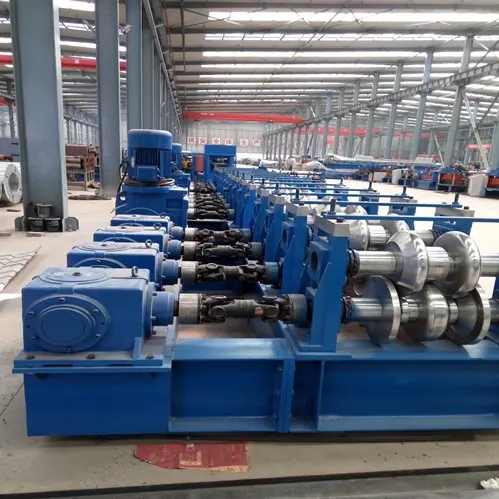
Cold Roll Forming Machines An Overview
Cold roll forming is a manufacturing process that shapes metal sheets into specific profiles by passing them through a series of rollers. This technique has gained wide acceptance across various industries, including construction, automotive, and appliance manufacturing. Cold roll forming machines are vital for producing high-quality, dimensionally accurate, and structurally sound products. This article delves into the mechanics, benefits, applications, and future trends associated with cold roll forming machines.
The Mechanism of Cold Roll Forming
The process of cold roll forming involves feeding a flat strip of metal, often steel, through a series of rollers arranged in a specific sequence. Each roller is designed to bend and shape the metal progressively. As the strip passes through the rollers, it is gradually formed into the desired cross-sectional profile without the need for heating, which distinguishes it from hot roll forming processes.
The machinery typically consists of various components, including a material uncoiler, a series of rollers, a cutting station, and a control system. The material uncoiler feeds the flat strip into the roller station where the actual forming occurs. The rollers are precision-engineered to ensure consistent pressure and shape. After the desired profile is achieved, the cutting station trims the material to specific lengths.
Advantages of Cold Roll Forming Machines
One of the principal advantages of cold roll forming is its ability to produce complex shapes with high precision. The process allows for tolerance levels as tight as ±0.5 mm, which is crucial for applications requiring exact specifications. Moreover, the method utilizes less material compared to traditional methods like stamping or machining, leading to reduced waste and cost savings.
Cold roll forming also enhances the mechanical properties of the material. The cold work hardening effect strengthens the metal, resulting in products that are notably more robust. This is particularly advantageous in structural applications where strength is a critical factor.
Additionally, the versatility of cold roll forming machines allows manufacturers to produce a wide range of profiles, from simple channels to intricate shapes. This flexibility means that businesses can cater to diverse market needs without investing in multiple specialized machines.

Applications Across Industries
Cold roll forming is prevalent in numerous industries due to its efficiency and adaptability. In the construction sector, it is used to create components such as metal studs, channels, and roofing systems, providing the backbone for many structural projects. The automotive industry utilizes cold roll forming to manufacture parts like chassis components, which require high strength-to-weight ratios.
Similarly, the appliance industry benefits from this technique, producing components for refrigerators, ovens, and HVAC systems. The ability to create lightweight yet sturdy designs is essential in these applications where energy efficiency is increasingly prioritized.
Emerging Trends and Future Prospects
As technology continues to evolve, cold roll forming machines are becoming increasingly sophisticated. Automation and computer numerical control (CNC) technology are being integrated into forming machines, enhancing precision and reducing labor costs. This shift towards automation allows manufacturers to maintain high production rates while ensuring consistent quality.
Additionally, the trend towards sustainability in manufacturing practices is influencing cold roll forming processes. Manufacturers are exploring ways to minimize energy consumption and reduce the carbon footprint of production. This includes optimizing machinery efficiency and utilizing environmentally friendly lubricants and coatings.
The growth of the renewable energy sector, particularly solar and wind energy, is also poised to create new opportunities for cold roll forming. As demand increases for components used in solar panels and wind turbines, the industry is likely to see expansion in this area. This shift aligns with global trends towards sustainable energy solutions.
Conclusion
Cold roll forming machines play a crucial role in modern manufacturing, offering an efficient, precise, and cost-effective method for producing a variety of metal profiles. With distinct advantages like reduced waste and enhanced strength, the applications of cold roll forming are extensive across several industries. As technological advancements and sustainability initiatives continue to shape the manufacturing landscape, cold roll forming is set to remain a pivotal process, adapting to meet the changing needs of the market.